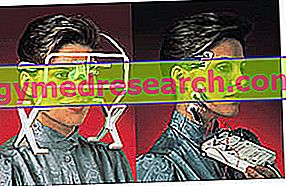By Dr. Andrea Gizdulich
Pathological occlusion can be defined as that capable of generating proprioceptive inputs that disturb normal muscle function and bring the mandible into malposition with the maxillary skull complex1-3. Real dental interferences caused by marked coronal malpositions, as well as simple pre-contacts, generate a sensory response, mostly coming from periodontal receptors, but also from all other stomatognathic proprioceptors, which inform the CNS of the disturbing element3. On the basis of this continuous information the CNS sets up a function model aimed at avoiding harmful contact, which causes a displacement of the mandibular bone and a consequent condylar displacement, of variable entity and absolutely individual: the masticatory muscles as well as the cervical and hyoid ones, they are therefore called upon to do additional work, having to work in order to originate and terminate every masticatory, phonatory and swallowing movement by integrating this new information. In other words, a new postural attitude of the jaw is achieved which must be maintained for all 24 hours and which will determine muscular hypertonus4, 5 of all the competent territories. The perpetuation of this functional request over time initiates an overload capable of generating real structural damage6-8 with formation of myofascial trigger points9, that is hypercontracted sarcomeres, shortened until they constitute small nodules contained within muscle bands, incapable to release for exhaustion of energy resources.
The mandibular dislocation, however, generates new areas of dental interference - secondary deflation contacts - which will in turn act by creating new proprioceptive information to be integrated and processed until the CNS stabilizes the mandible in the so-called maximum intercuspidation position (PMI), ie that Intermaxillary relationship determined by the largest possible number of dental contacts 2, 3. This cranio-mandibular relationship is regulated by the continuous dynamic equilibrium of sensory organs and neuromuscular actions, linked in a perpetual mechanism3.
Dental pre-contacts, commonly studied under static conditions, are widely understood in common practice as those areas of premature contact which is achieved by maintaining the mandible in a position of habitual occlusion or in centric relation10, following a "preconditioned" model of jaw positioning: the identification of these areas of first contact and their pathogenetic role cannot be of great significance if the surveys are performed keeping the mandible in a position induced and subjectively conditioned by the operator or even simply in the position of habitual occlusion of the patient, not necessarily physiological as conditioned by the patient's adaptive, proprioceptive memory. These analyzes, therefore, should be coordinated with other functional investigations able to demonstrate the physiological position of the jaw and its movement towards the position of maximum intercuspidation2, 3: this allows to identify the consequentiality of the dental contacts when the jaw moves along the individual neuromuscular trajectory, in maximum muscle balance.
The introduction of an occlusal check through TENS stimulation and application of adhesive waxes is ideally suited to this purpose, allowing the individual's neuromuscular trajectory to be found and the first deflationary contacts to be identified through involuntary muscle contractions2, 3.
On the contrary, investigating prematurity with simple articulation papers will not be a truly therapeutic act, nor will vision of the contact areas really inform about the work balance of the masticatory apparatus.
Every human being can easily cohabit with his / her functional structure, even if altered or pathological, and this arrangement can be elaborated over the years in a perception of health more or less assimilable to the ideal physiological conditions, but it can also suddenly and inexplicably exhaust the individual capacities of adaptation, starting to show algic-dysfunctional symptoms typical of cranio-mandibular disorders (DCM) 1-3, 11-13. The onset of painful and dysfunctional symptoms occurs in completely unpredictable ways and times, making any correlation between the degree of dysfunction and the extent of the symptomatology impossible.

For this purpose kinesiographic techniques of analysis of mandibular and electromyographic kinetics (EMG) have been in use for some time, with the aid of TENS2, 32, which represent the most reliable non-invasive means of functional investigation to measure the pathophysiological state of the apparatus masticatory18, 19.
However, a complete analysis should also include the assessment of areas and pressure loads made in the dental contact, which represents the final verification of the correct stomatognathic balance. It is evident that the mere demonstration of the good morphological matching of the arches or the vision of the contact surfaces between antagonist teeth cannot be sufficient in itself to demonstrate the physiopathologic state of the masticatory apparatus, but it represents an indispensable final verification of every dental therapy . whose orthopedic success can obviously not be achieved without ensuring adequate distribution of dental contacts 20. The analysis of the occlusal contacts was performed with the T-scan II system (Tekscan Occlusal Diagnostic System, Tekscan Inc ®) (Fig. 2 ), consisting of a printed circuit sensor 100 µm thick, housed on a support fork and connected to a computer that displays the contact areas and the degree of pressure reached.


It is also confirmed that the muscular and articular balance, expressed by the improvement of the oral opening both in the degree and in the fluidity of movement, can be achieved and maintained by minimizing the propioceptive input deriving from contacts on the cuspid slopes (interference according to Jankelson) 3 . These contacts in fact generate forces with tangential components to the teeth capable of damaging the tissues3, 12 and require a neuromotor regulation which, by causing an alteration of the spatial position of the jaw compared to that of neuromuscular equilibrium, triggers the framework of cranio-mandibular disorder.
BIBLIOGRAPHY
- 1. Bergamini M., Prayer Galletti S .: "Systematic manifestations of Musculo-Skeletal Disorders related to Masticatory Dysfunction." . Anthology of Skull-Mandibular Orthopedics. Coy RE Ed, Vol 2, Collingsville, IL: Buchanan, 1992; 89-102
- 2. Chan, CA .: "Power of neuromuscular occlusion-neuromuscular dentistry = physiologic dentistry." Paper presented at the American Academy of Craniofacial Pain 12th Annual Mid-Winter Symposium, Scottsdale, AZ, Jan. 2004.30.
- 3. Jankelson RR: "Neuromuscolar Dental Diagnosis and Treatment". Ishiyaku Euroamerica, Inc. Pubblisher, 1990-2005.
- 4. Ferrario VF, Sforza C, Serrao G, Colombo A, Schmitz JH. The effects of a single interchange on electromyographic characteristics of masticatory muscles during maximal voluntary teeth clenching. Skull 1999; 17 (3): 184-8.
- 5. Ferrario VF, Sforza C., Via C., Tartaglia GM: Evidence of an influence of asymmetrical occlusion on the activity of the sternocleidomastoid muscle. J Oral Rehabil 2003; 30: 34-40.
- 6. Bani D, Bani T, and Bergamini M. Morphologic and biochemical changes in mass muscle induced by occlusal wear: studies in a rat model. J Dent Res 1999; 78 (11): 1735.
- 7. Bani D, Bergamini M. Ultrastructural abnormalities of muscle spindles in the rat masseter muscle with malocclusion-induced damage.Histol Histopathol. 2002 Jan; 17 (1): 45-54.
- 8. Nishide N, Baba S, Hori N, Nishikawa H. Histological study of rat masseter muscle following experimental occlusal alteration. J Oral Rehabil 2001; 28 (3): 294-8.
- 9. Simons DG, Travell JC, Simons LS: Myofascial pain and dysfunction. Second Edition Williams & Wilkins, Baltimore, 1999.
- 10. Kerstein RB, Wilkerson DW. Locating the centric relation prematurity with a computerized occlusal analysis system. Compend Contin Educ Dent. 2001 Jun; 22 (6): 525-8, 530, 532 passim; quiz 536.
- 11. Bergamini M, Pierleoni F, Gizdulich A, Bergamini I. "Secondary dental headaches " in: Gallai V, Pini LA Treatise on headaches Scientific Center Publisher Turin, 2002.
- 12. Cooper BC, Kleinberg I. "Examination of a large patient population for the presence of symptoms and signs of temporomandibular disorders". Skull. 2007 Apr; 25 (2): 114-26.
- 13. Pierleoni F., Gizdulich A .: "Clinical statistical survey on cranio-mandibular disorders." Ris 2005; 3: 27-35.
- 14. Seligman DA, Pullinger AG. The role of functional occlusal relationships in temporomandubular disorders: a review. J Craniomandb Disord. 1991 Fall; 5 (4): 265-279.
- 15. Pullinger AG, Seligman DA. Quantification and validation of a predictive value of occlusal variabiles in temporo-mandibular disorders using a multifactor analysis. J Prothet Dent. 2000 Jan; 83 (1): 66-75.
- 16. Michelotti A, Farella M, Steenks MH, Gallo LM, Palla S. No effect of experimental occlusal interferences on pressure pain thresholds of the masseter on temporalis muscles in healthy women. Eur J Oral Sci 2006; 114 (2): 167-170.
- 17. Michelotti A, Farella M, Gallo LM, Veltri A, Palla S, Martina R. Effect of occlusal interference on habitual acivity of human masseter. J Dent Res 2005; 84 (7): 644-8.
- 18. Cooper BC, Kleinberg I. Establishment of a temporomandibular physiological state with neuromuscular orthosis treatment affects reduction of TMD symptoms in 313 patients. Skull. 2008 Apr; 26 (2): 104-17.
- 19. Kamyszek G, Ketcham R, Garcia R, JR, Radke J: "Electromyographic evidence of reduced muscle activity when ULF-TENS is applied to the Vth and VIIth cranial nerves." Skull 2001, 19 (3): 162-8.
- 20. Garcia, VCG, Cartagena, AG, Sequeros, OG Evaluation of occlusal contacts in maximum intercuspation using the T-Scan system. J Oral Rehabil 1997; 24: 899-903.
- 21. Kerstein RB. Combining technologies: a computerized occlusal analysis system synchronized with a computerized electromyography system. Skull 2004; 22 (2): 96-109.
- 22. Hirano S, Okuma K, Hayakawa I. In vitro study of accuracy and repeatability of the T-scan II system. Kokubio Gakkai Zasshi 2002; 69 (3): 194-201.
- 23. Mizui M, Nabeshima F, Tosa J, Tanaka M, Kawazoe T. Quantitative analysis of occlusal balance in the intercuspal position usin the T-scan system. Int J Prosthodont 1994; 7 (1): 62-71.



